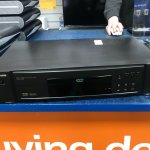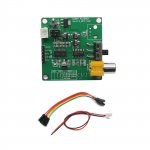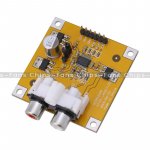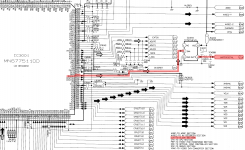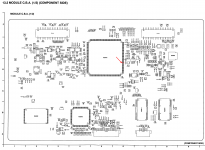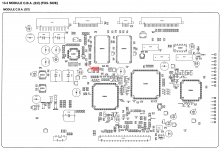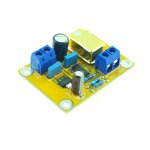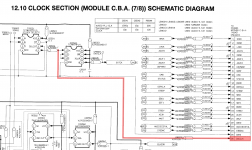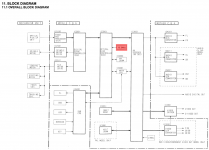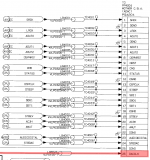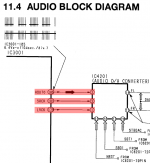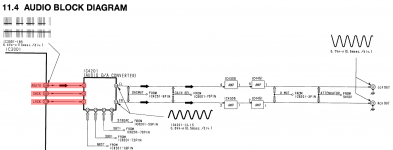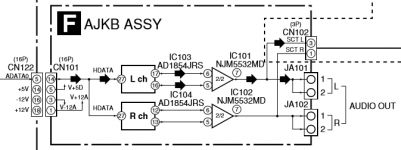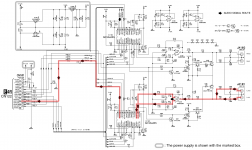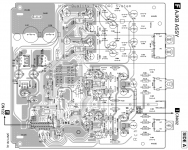Hi folks
My CDP died so I need to buy a replacement, and I figured, with the advances in DACs and the plethora of boards available cheaply, I could take a cheap CDP from the 80s or 90s and add a modern DAC board for a significant upgrade in sound quality.
I keep reading that all the modern DACs sound the same if implemented properly, so I'm wondering what DAC board I should buy.
Secondly, I'm wondering if it's as straightforward as connecting the I2S signal from the CDP to the input of the DAC board - 'stealing' the signal from where it enters the built-in DAC chip of the CDP. I have read that there is an issue with the I2S of the receiver chip in the CDP not being compatible with modern DAC boards that use DSD.
Does that mean I would need to use a CDP with an SPDIF output and a SPDIF receiver board such as the DIR9001 to interface the DAC board to the CDP?
I'm thinking a cheap CDP + DAC board and doing a few other mods/upgrades to the power supplies in the CDP, any models of CDP people would recommend as being suitable for such a project?
My CDP died so I need to buy a replacement, and I figured, with the advances in DACs and the plethora of boards available cheaply, I could take a cheap CDP from the 80s or 90s and add a modern DAC board for a significant upgrade in sound quality.
I keep reading that all the modern DACs sound the same if implemented properly, so I'm wondering what DAC board I should buy.
Secondly, I'm wondering if it's as straightforward as connecting the I2S signal from the CDP to the input of the DAC board - 'stealing' the signal from where it enters the built-in DAC chip of the CDP. I have read that there is an issue with the I2S of the receiver chip in the CDP not being compatible with modern DAC boards that use DSD.
Does that mean I would need to use a CDP with an SPDIF output and a SPDIF receiver board such as the DIR9001 to interface the DAC board to the CDP?
I'm thinking a cheap CDP + DAC board and doing a few other mods/upgrades to the power supplies in the CDP, any models of CDP people would recommend as being suitable for such a project?
Last edited:
"I keep reading that all the modern DACs sound the same if implemented properly"
There are plenty of people who strongly disagree with that statement.
Aside from that issue, most people simply rip CDs and play them from a PC or maybe a low-cost streamer, such as RPi.
Regarding the 'simplicity' of grabbing I2S signals and routing them into a dac, its not necessarily all that simple and how you do it can effect resulting sound quality. Moreover, dacs with I2S inputs typically require LVDS signals, whereas I2S signals found in a CD player are almost certainly LVCMOS. Thus, some signal conversion circuity would need to be designed, built, tested, and possibly...debugged.
There are plenty of people who strongly disagree with that statement.
Aside from that issue, most people simply rip CDs and play them from a PC or maybe a low-cost streamer, such as RPi.
Regarding the 'simplicity' of grabbing I2S signals and routing them into a dac, its not necessarily all that simple and how you do it can effect resulting sound quality. Moreover, dacs with I2S inputs typically require LVDS signals, whereas I2S signals found in a CD player are almost certainly LVCMOS. Thus, some signal conversion circuity would need to be designed, built, tested, and possibly...debugged.
Last edited:
I'm thinking a cheap CDP + DAC board and doing a few other mods/upgrades to the power supplies in the CDP, any models of CDP people would recommend as being suitable for such a project?
This is the only relatively cheap current production CD player I have found where the DAC chip's inputs can be tapped off : ??/Cayin/??? MINI-CD ???CD????????CD?-???
Going cheaper than this gets you into the realm of DVD players where the DAC chips are always integrated. Hence no external I2S.
Hi folks
My CDP died so I need to buy a replacement, and I figured, with the advances in DACs and the plethora of boards available cheaply, I could take a cheap CDP from the 80s or 90s and add a modern DAC board for a significant upgrade in sound quality.
It all depends on what you bring to the party. Bring the right skillset and that twin ES9038 based CDP-101 can be yours in a jiffy. If not, you may have to settle for SPDIF links inside the box. Put forward some options and see where things go from there.
This is the only relatively cheap current production CD player I have found where the DAC chip's inputs can be tapped off : ??/Cayin/??? MINI-CD ???CD????????CD?-???
Going cheaper than this gets you into the realm of DVD players where the DAC chips are always integrated. Hence no external I2S.
Thanks for the suggestion. When I said cheap CDP, I mean an old one secondhand from eBay, something with lots of room inside to add stuff.
"I keep reading that all the modern DACs sound the same if implemented properly"
There are plenty of people who strongly disagree with that statement.
Aside from that issue, most people simply rip CDs and play them from a PC or maybe a low-cost streamer, such as RPi.
Regarding the 'simplicity' of grabbing I2S signals and routing them into a dac, its not necessarily all that simple and how you do it can effect resulting sound quality. Moreover, dacs with I2S inputs typically require LVDS signals, whereas I2S signals found in a CD player are almost certainly LVCMOS. Thus, some signal conversion circuity would need to be designed, built, tested, and possibly...debugged.
Yeah, I thought it wasn't so simple. My current plan is to use a player with a digital output, steal the PCM SPDIF signal and route it to a DIR9001 receiver board then feed that into a DAC board.
To that end, and wanting to have something up and running quickly, I've bought a Panasonic DVD-A160 player for the princely sum of 12.49 inc postage, a DIR9001 board for 12.58 and a PCM5102 board for 6.26.
I plan to lash these together so I have something to listen to my CDs with, then take my time on something rather more sophisticated and expensive using a better CD player and a dual DAC board and go the whole hog with multiple low noise PSUs etc.
Attachments
It all depends on what you bring to the party. Bring the right skillset and that twin ES9038 based CDP-101 can be yours in a jiffy. If not, you may have to settle for SPDIF links inside the box. Put forward some options and see where things go from there.
Indeed, I figure this will be a long term project over the coming months, to begin with I'll have a simple setup with SPDIF inside the box, then move on to something a bit more complex.
I chose the Panasonic DVD-A160 not only because it's cheap, but it has an extremely detailed service manual. After studying which, I think it should be fairly straightforward to steal the SPDIF coming from the decoder chip and route it into the DIR9001 receiver.
The signal comes out of pin 174 of the decoder chip and passes to pin 2 of a small IC conveniently mounted on the front of the board, I figure I'll simply solder a wire directly to pin 2 of that IC.
I'll probably leave the rest of the player as-is, just adding a small transformer with two 6v secondary windings and a pair of regulated supples to power the receiver and DAC boards.
I chose the PCM5102 board because it is a V out type that puts out the correct 2v so no need for any output stage. I can get fancy with I-V converters and output stages in the more complex thing I build.
Attachments
If you use dac boards with I2S inputs but that also require an external MCLK input, then you should check what frequency MCLK signal the CD player uses. Some of them don't use standard MCLK frequencies most modern dac chips are designed to work with. You would at least be advised to determine the CD player MCLK frequency and study the data sheet of any prospective dac chip to make sure you can configure them to work together. OTOH, if you use an ESS based dac board, then the dac chip's internal ASRC can allow for operation of the CD transport system with one MCLK, and the dac chip with a different MCLK. Another way to do the same thing would be use a separate ASRC chip between the CD player I2S output and the dac I2S input.
Last edited:
The Panasonic player has a BB PCM1734 DAC in it and according to the block diagram in the SM, there is a 16.9MHz clock, which I take it is being passed to the PCM1734. Looking at the schematic of the clock section, I see that there is a 26-pin connector carrying signals to the mother board where the DAC is located and pin 26 is labelled DACCLK which I take to be the 16.9MHz signal. If so, I can simply connect a wire from pin 26 to my PCM5102 board.
If not, I happen to have a 16.9MHz clock module I could install.
If not, I happen to have a 16.9MHz clock module I could install.
Attachments
It just occurred to me that I might not need the DIR9001 receiver board. The player's PCM1734 DAC will probably be receiving data in the same format as the PCM5102 board requires and those data signals will be carried on some of the pins of that 26-pin connector that leads from the clock module to the motherboard as it is labelled ADAC for Audio DAC. So I think it's just a case of figuring out which of those signals to steal and connect to the PCM5102 board?
The PCM5102 board has three inputs labelled LRCK, BCK and DATA.
According to the SM, the corresponding three signals being sent to the PCM1734 are labelled LRCK, SRCK and AOUT0 and it seems pretty obvious that LRCK corresponds to LRCK, SRCK to BCK and AOUT0 to DATA. These three signals are on pins 179, 181 and 185 of the decoder chip and are carried on pins 1, 3 & 4 of the 26-pin connector that leads from the clock module to the motherboard.
So it seems to me that I could simply steal those three signals and the clock signal from the 26-pin connector and route them to the PCM5102 board.
The PCM5102 board has three inputs labelled LRCK, BCK and DATA.
According to the SM, the corresponding three signals being sent to the PCM1734 are labelled LRCK, SRCK and AOUT0 and it seems pretty obvious that LRCK corresponds to LRCK, SRCK to BCK and AOUT0 to DATA. These three signals are on pins 179, 181 and 185 of the decoder chip and are carried on pins 1, 3 & 4 of the 26-pin connector that leads from the clock module to the motherboard.
So it seems to me that I could simply steal those three signals and the clock signal from the 26-pin connector and route them to the PCM5102 board.
Attachments
Last edited:
There can only be one clock oscillator at time for one reproduction system, or else ASIO or FIFO is required.
Do you have an oscilloscope for this?
Probably wise to take a look at PCM1734 datasheet to see what it says about master clocks.
You know that LVCMOS I2S signal wires can only be a few CM long, right? That's why dacs with I2S inputs use LVDS.
Do you have an oscilloscope for this?
Probably wise to take a look at PCM1734 datasheet to see what it says about master clocks.
You know that LVCMOS I2S signal wires can only be a few CM long, right? That's why dacs with I2S inputs use LVDS.
Last edited:
There doesn't appear to be any published info available on the PCM1734, it's a mystery chip.
No, I don't have an oscilloscope.
This is a learning experience for me as much as anything else, play with some cheap kit before getting into anything more complex and expensive.
The audio path from the decoder to the DAC and then to the RCA outputs is fairly simple, just two opamps, both NJM4580M and the consensus seems to be that even the NE5532 would be significantly superior in sound quality. There's a pair of 850 ohm resistors and 2SD1328 muting transistors in the output stage as well.
Because I don't have any info on the PCM1734, I have no idea if it is an I out or V out type, so I don't think there is much point in reworking the output stage downstream of the PCM1734 chip, especially as this isn't a particularly good CD/DVD player to begin with, no sense in polishing a turd too much.
No, I don't have an oscilloscope.
This is a learning experience for me as much as anything else, play with some cheap kit before getting into anything more complex and expensive.
The audio path from the decoder to the DAC and then to the RCA outputs is fairly simple, just two opamps, both NJM4580M and the consensus seems to be that even the NE5532 would be significantly superior in sound quality. There's a pair of 850 ohm resistors and 2SD1328 muting transistors in the output stage as well.
Because I don't have any info on the PCM1734, I have no idea if it is an I out or V out type, so I don't think there is much point in reworking the output stage downstream of the PCM1734 chip, especially as this isn't a particularly good CD/DVD player to begin with, no sense in polishing a turd too much.
Attachments
Last edited:
Regarding PCM1734, sometimes customers who buy lots of chips can get a custom part number assigned to them, so it looks exclusive. That said, not knowing which datasheet to look at could be a problem. Maybe a good reason to try another chip.
Regarding getting into electronics, not having any kind of scope at all is pretty crippling. Even an old used one from ebay would be better than nothing.
Regarding getting into electronics, not having any kind of scope at all is pretty crippling. Even an old used one from ebay would be better than nothing.
Here's the schematic of the DAC section, it's a 28 pin chip like the PCM179x series, there's 0.1v of gain between the output of the PCM1734 and the RCA outputs, so I think the two opamps are there as a gain stage and a buffer. The signal path isn't as convoluted as it might be.
Attachments
As regards building a cheap cd player into a nice dac, my experience is the actual cd mechanism is the weak point with any disc spinner.
I have just bought a £5 cd rom drive and one of those cd rom controller from China. The cd rom drive has am spdif out out that I will try to feed into my AK4118 spdif to i2s converter and then feed those 3 i2s lines into an AD1862.
See how it all works out.
Using the above 4118/1862 but fed optical from a Chromecast audio sounds very good, so it will be a comparison of spdif output qualities.
I have just bought a £5 cd rom drive and one of those cd rom controller from China. The cd rom drive has am spdif out out that I will try to feed into my AK4118 spdif to i2s converter and then feed those 3 i2s lines into an AD1862.
See how it all works out.
Using the above 4118/1862 but fed optical from a Chromecast audio sounds very good, so it will be a comparison of spdif output qualities.
Last edited:
Hi Jim
You hit on exactly what I had intended to do back in 2018 but was stopped from completing the project by illness. I had bought all the parts - WM8805 board and dual AK4xxx (I forget which exactly, 4492?) DAC, one of those CD-ROM controllers, a case, a CD drive, etc. It all got put away in a cardboard box to be completed when my health returned. That box appears to have fallen through some kind of inter-dimensional portal and disappeared, I have searched high and low for it in the last couple of weeks and not found it.
Please keep us informed of your progress with your project as I still think I will end up following that path again.
You hit on exactly what I had intended to do back in 2018 but was stopped from completing the project by illness. I had bought all the parts - WM8805 board and dual AK4xxx (I forget which exactly, 4492?) DAC, one of those CD-ROM controllers, a case, a CD drive, etc. It all got put away in a cardboard box to be completed when my health returned. That box appears to have fallen through some kind of inter-dimensional portal and disappeared, I have searched high and low for it in the last couple of weeks and not found it.
Please keep us informed of your progress with your project as I still think I will end up following that path again.
Well, there has been an unexpected development. My sister said to me this morning 'oh, I've got an old DVD player in the cupboard, you can have it' so I went and got it, expecting it to be some cheap crappy sounding thing that will at least allow me to listen to my CDs while I work on something better.
Nope, it's a Pioneer DV-737 and it sounds really excellent,better than my Marantz CD-63 that has died and needs replacing. Not just a little bit better either, quite a lot better.
Intrigued at this unexpected sound quality, I had a peek at the SM and bugger me, it's got a damn good audio section with not one but two AD1864s working as a mono pair and just one NE5532 per channel to do the I/V conversion. The power supply arrangement is pretty good too - the audio section receives +/- 12V and +5V from the main switching PSU board and had three local regulators, a 7805 and a 7809/7909 to produce a clean +5v for the DACs and a clean +/- 9v for the NE5532s.
So there's not a whole lot to do to improve this setup, I could remove the NE5532s and fit a pair of sockets then try some better op-amps such as OPA2134 instead, I could replace the local 7805 with a more modern low noise regulator, but these are only likely to give pretty small improvements. I could remove the muting transistors too, but I don't want any loud pops and it's a fair bit of work to fit relays to replace the trannies. I note that the muting circuit in this Pioneer isn't the usual pair of trannies, but rather it has three BJTs and a MOSFET per channel, connecting the mute pin of the DAC to the output. Not seen an arrangement like that before, anyone know why it has been done this way?
So in all, I think I'll leave this Pioneer DV-737 as it is and just enjoy listening to my CDs with it.
This now means I don't need to get the Panasonic DVD-A160 up and running ASAP so I can take my time fiddling with it and learning the skills needed to modify/upgrade a CD/DVD player.
Here's the details of the Pioneer from the SM, I'm very surprised to see such a well designed audio section in a DVD player, this is better than I've seen in the vast majority of high end players and is more like you would find in an Arcam or something else that has been well designed.
Nope, it's a Pioneer DV-737 and it sounds really excellent,better than my Marantz CD-63 that has died and needs replacing. Not just a little bit better either, quite a lot better.
Intrigued at this unexpected sound quality, I had a peek at the SM and bugger me, it's got a damn good audio section with not one but two AD1864s working as a mono pair and just one NE5532 per channel to do the I/V conversion. The power supply arrangement is pretty good too - the audio section receives +/- 12V and +5V from the main switching PSU board and had three local regulators, a 7805 and a 7809/7909 to produce a clean +5v for the DACs and a clean +/- 9v for the NE5532s.
So there's not a whole lot to do to improve this setup, I could remove the NE5532s and fit a pair of sockets then try some better op-amps such as OPA2134 instead, I could replace the local 7805 with a more modern low noise regulator, but these are only likely to give pretty small improvements. I could remove the muting transistors too, but I don't want any loud pops and it's a fair bit of work to fit relays to replace the trannies. I note that the muting circuit in this Pioneer isn't the usual pair of trannies, but rather it has three BJTs and a MOSFET per channel, connecting the mute pin of the DAC to the output. Not seen an arrangement like that before, anyone know why it has been done this way?
So in all, I think I'll leave this Pioneer DV-737 as it is and just enjoy listening to my CDs with it.
This now means I don't need to get the Panasonic DVD-A160 up and running ASAP so I can take my time fiddling with it and learning the skills needed to modify/upgrade a CD/DVD player.
Here's the details of the Pioneer from the SM, I'm very surprised to see such a well designed audio section in a DVD player, this is better than I've seen in the vast majority of high end players and is more like you would find in an Arcam or something else that has been well designed.
Attachments
Last edited:
The Panasonic DVD-A160 just arrived and it works fine. It sounds quite good but definitely less good than the Pioneer, however it's certainly respectable compared to most domestic CD players. I shall get the top off and start examining the innards. Photos to follow...
...Intrigued at this unexpected sound quality...
You are not the first to have such an experience. What you will find if you keep listening is that all modern dacs do not the sound the same. That is true despite those people who repeat stories having the superficial appearance of science about why modern dacs must sound the same.
Last edited:
That's because not all meet the same spec. IOW, there are esoteric DACs out there. Also, you should be aware that same DAC can sound different depending on how you listen to it.all modern dacs do not the sound the same.
- Home
- Source & Line
- Digital Line Level
- CD player upgrade project
